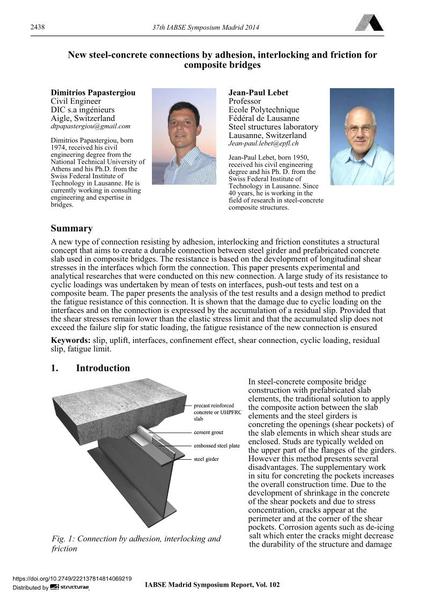New steel-concrete connections by adhesion, interlocking and friction for composite bridges

|
|
|||||||||||
Bibliographic Details
| Author(s): |
Dimitrios Papastergiou
Jean-Paul Lebet |
||||
|---|---|---|---|---|---|
| Medium: | conference paper | ||||
| Language(s): | English | ||||
| Conference: | IABSE Symposium: Engineering for Progress, Nature and People, Madrid, Spain, 3-5 September 2014 | ||||
| Published in: | IABSE Symposium Madrid 2014 | ||||
|
|||||
| Page(s): | 2438-2445 | ||||
| Total no. of pages: | 8 | ||||
| Year: | 2014 | ||||
| DOI: | 10.2749/222137814814069219 | ||||
| Abstract: |
A new type of connection resisting by adhesion, interlocking and friction constitutes a structural concept that aims to create a durable connection between steel girder and prefabricated concrete slab used in composite bridges. The resistance is based on the development of longitudinal shear stresses in the interfaces which form the connection. This paper presents experimental and analytical researches that were conducted on this new connection. A large study of its resistance to cyclic loadings was undertaken by mean of tests on interfaces, push-out tests and test on a composite beam. The paper presents the analysis of the test results and a design method to predict the fatigue resistance of this connection. It is shown that the damage due to cyclic loading on the interfaces and on the connection is expressed by the accumulation of a residual slip. Provided that the shear stresses remain lower than the elastic stress limit and that the accumulated slip does not exceed the failure slip for static loading, the fatigue resistance of the new connection is ensured |
||||
| Keywords: |
uplift cyclic loading shear connection interfaces confinement effect Slip residual slip fatigue limit
|
||||
